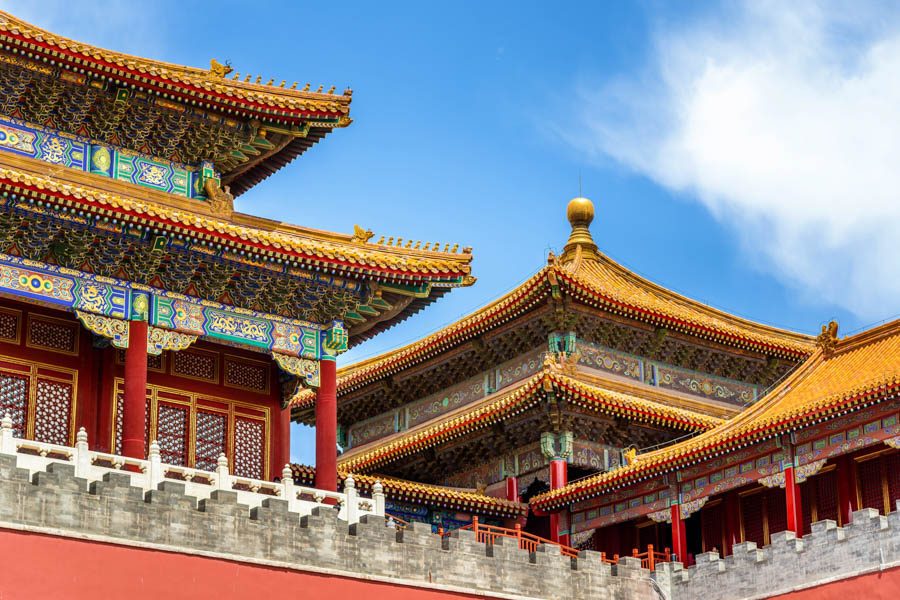
Chinese architecture is one of the most striking forms of Chinese art and culture. Over the centuries, it has absorbed influences from many eras and traditions while maintaining its own identity. Every feature carries symbolism, a pursuit of balance, and deep respect for tradition – values handed down through generations and still visible today. This continuity makes architecture a living record, where ancient principles meet modern design and shape contemporary cities. Welcome to the world of Chinese architecture, as rich and diverse as the country’s history itself.
Journey Through Time: The Intriguing Evolution of Chinese Architecture
Chinese architecture has a rich history that has evolved since the Neolithic era, showcasing diverse styles that invite you to explore the stories behind each magnificent structure. Key types include imperial architecture with grand palaces, religious buildings like temples, residential homes featuring traditional courtyards, garden architecture that harmonises with nature, and military structures, exemplified by the Great Wall.
The Qin Dynasty (221–206 BC) and Han Dynasty (206 BC–220 AD) marked a shift toward a unified architectural style, while the Tang Dynasty (618–907 AD) introduced expansive designs. The Song Dynasty (960–1279 AD) and Yuan Dynasty (1271–1368 AD) refined architectural details, standardised by the Yingzao Fashi manual. Urban expansion during the Ming Dynasty (1368–1644 AD) and Qing Dynasty (1644–1912 AD) produced iconic structures like the Drum and Bell Towers.
The Silk Road was not only a trade route but also a vital channel for the exchange of architectural ideas and techniques. Merchants and travellers introduced construction methods and design concepts from various cultures, allowing architectural styles to blend and evolve. Chinese influences can be seen as far as the Middle East and Europe.
In the 20th century, rapid urbanisation in cities like Beijing and Shanghai brought a fusion of traditional and modern designs, reflecting a continuous pursuit of beauty, order, and harmony throughout Chinese society.
Discover more about the rich history of Chinese architecture, its remarkable structures, and the evolution of styles in our detailed historical guide.
Faith and Form: The Influence of Religion and Philosophy
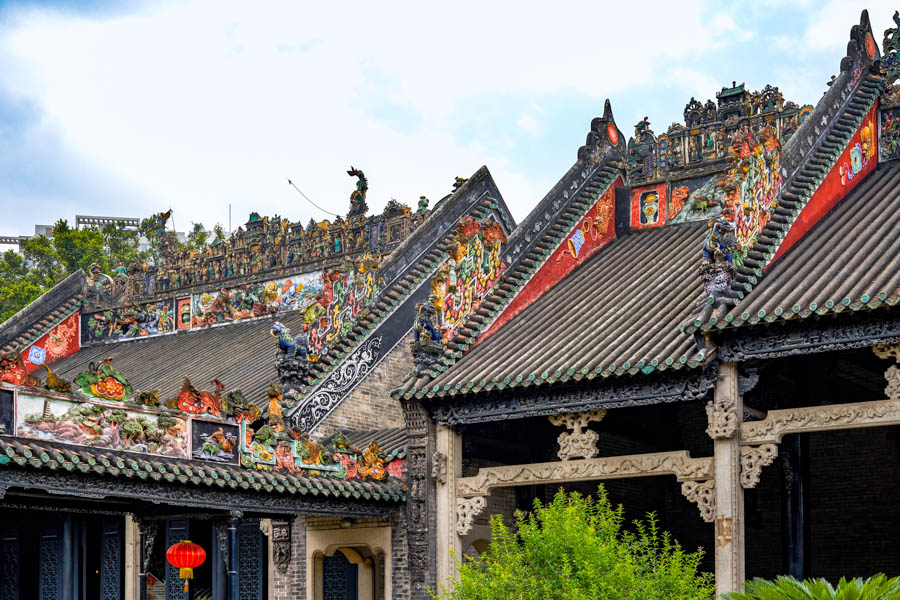
China’s diverse religious traditions and philosophical schools have shaped a rich architectural legacy. Over centuries, they combined native forms with borrowed elements, reflecting both local beliefs and global influences.
Confucianism: Harmony and Symbolism
Confucianism, since the 6th-5th centuries BC, has profoundly influenced Chinese architecture by blending aesthetics with philosophy. As you explore this heritage, key materials like wood, ceramics, and stone symbolise strength and longevity. Notable colours include red for good fortune and yellow for emperors, enhancing the beauty of structures. This influence spans from temples to private homes and ancestral halls, where courtyards promote communal harmony and unity.
Architectural designs often incorporate feng shui principles, optimising energy flow while reflecting Confucian ideals of balance. Intricate carvings and painted motifs narrate moral stories, revealing China's rich cultural tapestry. A must-visit is the Forbidden City in Beijing, where you can experience first-hand the harmony, order, and social hierarchy that define this magnificent architectural marvel.
Taoism: Balance and Nature
Taoism, emerging around the 4th century BCE, offered an alternative vision to Confucian order, emphasising harmony with nature and the inner life. Its principles strongly influenced Chinese architecture. Taoist temples were designed to integrate seamlessly with their surroundings, often set among rocks, caves, trees, streams, or mountains, reflecting the philosophy’s reverence for the natural world. Asymmetrical layouts symbolised the fluidity and constant change of life, while materials like wood and stone were chosen to complement the environment. Colours and decorative elements carried symbolic meanings, representing qi energy and cosmic balance. Specific colours may vary but often include the colours associated with the five elements: green, linked to wood; red, associated with fire; yellow, linked to earth; white, representing metal; and blue or black, associated with water. Notable examples include Qingcheng Mountain’s hidden temples, Wudang Mountain’s pavilion terraces, Taiqing Palace on Mount Laoshan, and Yongle Gong in Shanxi, whose architecture and vibrant wall paintings embody Taoist ideals of unity between people and nature.
Buddhism: Sacred Geometry and Tranquillity
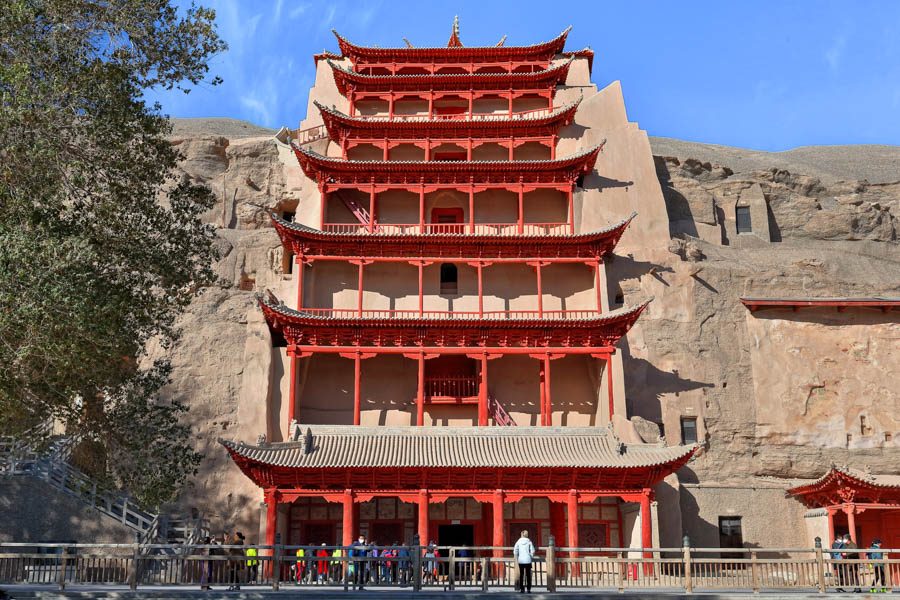
Buddhism entered China in the 1st century BCE via the Silk Road and took root with the first temple in Luoyang. Imperial patronage helped it flourish, giving rise to distinctive temples, pagodas, and cave sanctuaries. Wooden and brick structures featured balanced forms and symbolic details such as lotus-shaped roofs and tiered pagodas expressing spiritual ascent. The Mogao Caves, White Horse Pagoda, and Shaolin Temple remain enduring icons of Buddhist culture, while Xi’an’s Big and Small Wild Goose Pagodas, built without mortar, have survived centuries of earthquakes. Together they show how Buddhism reshaped China’s architectural landscape, uniting faith, artistry, and harmony in lasting forms.
Islam: Design and Faith
Islam reached China in the 8th century during the Tang dynasty, carried by merchants along the Silk Road. Trade soon grew into enduring cultural and religious connections, and mosques appeared across the empire. Chinese Islamic architecture blended local and foreign traditions: tiled roofs, wooden gateways, and curved eaves paired with Quranic calligraphy and geometric patterns. The Great Mosque of Xi’an and Beijing’s Niujie Mosque embody this harmony of faith and form. Regional variations flourished – eastern mosques echo Taoist temples in serene courtyards, while in the west, domes and tall minarets reflect Central Asian influence. The Id Kah Mosque in Kashgar and Urumqi’s Tatar Mosque remain vivid symbols of this cross-cultural architectural legacy.
Christianity: Light and Structure
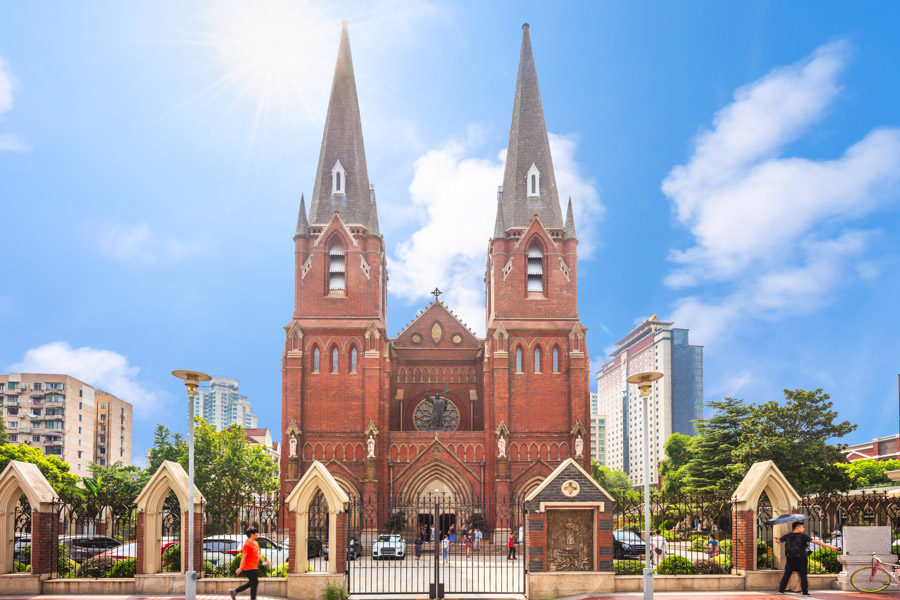
The arrival of Christianity in China occurred during the Tang dynasty, when Nestorian missionaries from Persia preached in Chang’an in 635. Their legacy is preserved in the Nestorian Stele of 781, displayed in Xi’an’s Museum of Stone Steles. Later waves of Catholic and Protestant missions spread the faith across the country, and churches became part of China’s urban landscape. Many adopted Gothic and Baroque styles, with stained glass, pointed arches, and tall spires. St Ignatius Cathedral in Shanghai stands as a grand Gothic monument, while Beijing’s Cathedral of the Immaculate Conception represents the Baroque tradition. However, the extent of Christianity’s influence on traditional Chinese architecture is generally not significant.
Chinese Folk Religion: Ritual and Space
Chinese folk religion unites ancestor worship, reverence for nature, and belief in Heaven as a cosmic force maintaining harmony and order. Its architecture is best embodied in ancestral halls – spaces devoted to family remembrance and community gatherings. Typically aligned on a south-facing axis, they feature central ritual halls and side chambers for offerings. Roofs with upturned eaves display protective creatures, while gates guarded by stone lions bear plaques praising family virtues. Interiors blend carved wooden panels, red and gold motifs, and stone floors symbolising stability. The Chen Clan Ancestral Hall in Guangzhou exemplifies this tradition, with its ornate ceramic roof figures, floral stone reliefs, and richly gilded woodwork celebrating lineage and harmony.
Discover the Allure of Traditional Chinese Architecture
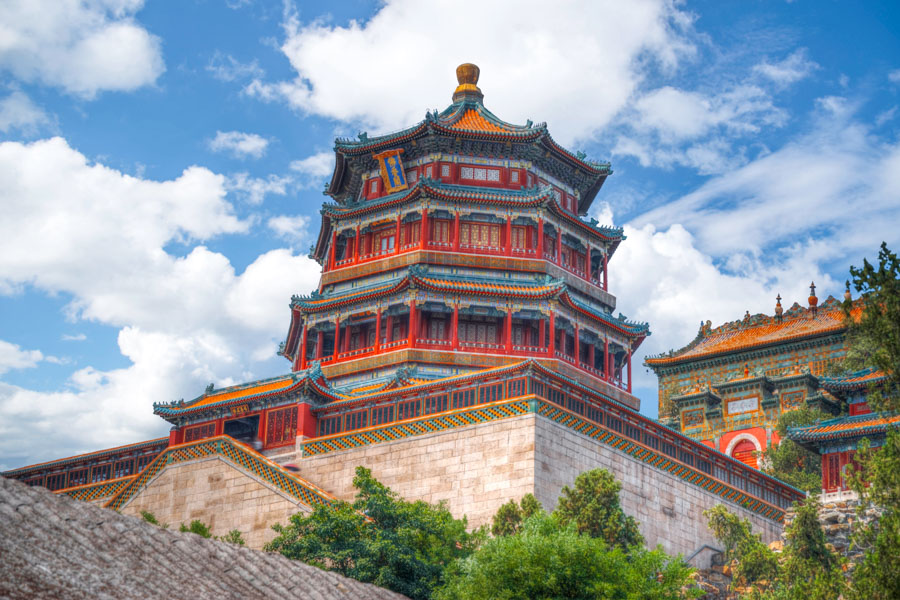
Traditional Chinese architecture is instantly recognisable, reflecting deep philosophical and cultural values through its practical and symbolic features.
The harmony and balance inherent in this architectural style are shaped not only by historical contexts but also by local adaptations to geography and climate, allowing for a rich tapestry of design across the country.
What gives it such unique character and lasting appeal?
Feng Shui Principles
Feng Shui is essential to Chinese architecture, guiding the creation of balanced spaces that enhance daily life. Rooted in ancient philosophy, it influences the layout, orientation, and design of buildings.
Central to Feng Shui is the belief in qi (energy), which affects health, prosperity, and well-being. Architects aim to arrange spaces considering the landscape, terrain, sunlight, and wind to ensure positive qi circulation.
Must-See Landmarks: The Forbidden City (Beijing) and The Ming Dynasty Tombs (near Beijing).
Curved Roof Design
Resembling the wings of a bird in flight, curved roofs are iconic in Chinese architecture and symbolise freedom and aspiration. They are associated with protection and harmony, as their sweeping slopes and upturned eaves are believed to ward off evil spirits and retain positive energy.
Noteworthy Sites to Explore: The Temple of Heaven and the Summer Palace (Beijing)
Courtyard House Layout
The courtyard house, or Siheyuan, is a classic form of Chinese dwelling built around an enclosed central yard, providing residents with a private and tranquil retreat. Layouts are typically symmetrical, with rooms arranged along the courtyard’s perimeter. Many feature landscaped gardens that extend the living space outdoors, often featuring rocks, ponds, plants, and pavilions designed to create serenity.
Significant Architectural Highlights: The Siheyuan of Beijing and The Courtyard Houses of Lijiang (Yunnan Province).
Use of Natural Materials
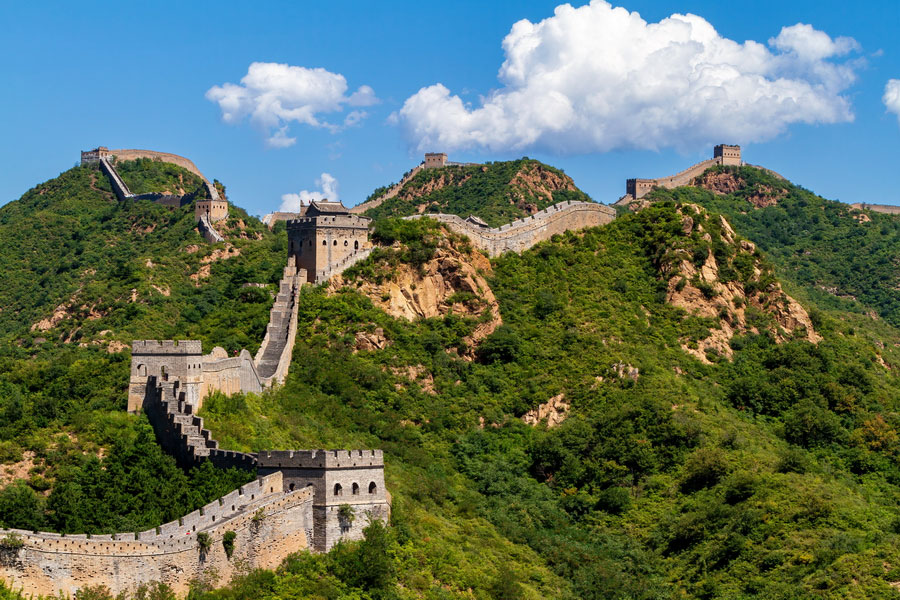
Traditional Chinese architecture relies heavily on natural materials like wood, stone, ceramics, and sometimes bamboo. Wood, the primary structural element, is valued for its strength and beauty, enhanced by intricate carving that showcases craftsmanship. Stone provides stability and durability for foundations, steps, and decorative elements, giving buildings stability.
Ceramic roof tiles, often glazed in vivid colours, offer protection while adding decorative charm and cultural significance – different colours can denote various meanings or regional styles. Bamboo, known for its flexibility and rapid growth, serves as a sustainable option.
This emphasis on natural materials highlights harmony with the environment and the connection between people and nature, reflecting ancient beliefs about living in balance and ensuring that buildings blend seamlessly with their landscapes.
Architectural masterpieces to visit: The Great Wall of China (Badaling and Mutianyu sections) and the Yingxian Wooden Pagoda
North–South Axis and Spatial Symmetry
A north–south orientation is a defining principle of traditional Chinese buildings, ensuring optimal sunlight and protection from harsh winds. Symmetry along a central axis reflects the philosophical ideals of order and balance essential to Chinese thought.
These principles not only shape the distinctive appearance of structures across the country but also influence their functionality and spatial arrangement.
Key Sites of Architectural Importance: Beijing Central Axis which consists of former imperial palaces and gardens, sacrificial structures, and ceremonial and public buildings.
Ornamentation in Traditional Chinese Architecture
Ornamentation plays a vital role in traditional Chinese architecture, enhancing both aesthetic appeal and cultural significance. Intricate carvings, colourful paintings, and symbolic motifs adorn structures, often depicting scenes from mythology, nature, or historical events. These decorative elements are not merely for beauty; they convey deeper meanings related to luck, prosperity, and harmony, inviting observers to appreciate the rich narratives embedded within the architecture. From the elaborate eaves of temples to the detailed door frames of homes, ornamentation transforms buildings into expressive works of art reflecting Chinese cultural values.
Decipher the Secrets: Symbolism in Chinese Traditional Architecture
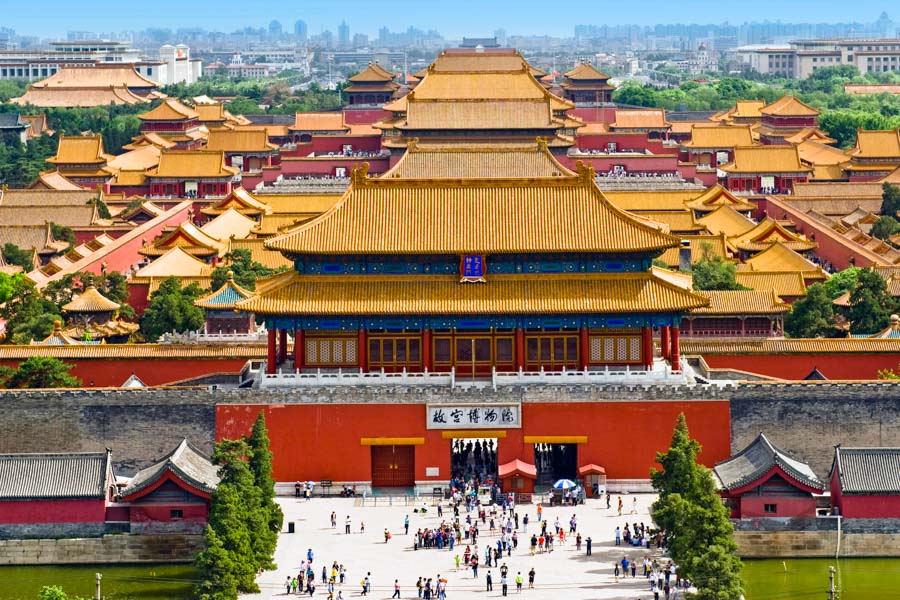
Chinese traditional architecture is a vivid tapestry of symbolism, where mythical creatures, flora, and natural elements come together to tell a story. You will notice that buildings often feature beautiful plants, such as lotuses, which represent purity, and pine trees, symbolising endurance. Water is another important element, frequently included in gardens and ponds to signify wealth and harmony.
You will also find writing characters woven into decorative motifs, expressing meanings related to happiness and longevity. The shapes of structures themselves bear significance; for example, round roofs symbolise heaven, while square bases embody the earth, reflecting a harmonious balance between these realms.
Heaven is revered in China, historically called the “Celestial Empire”, symbolising the link between earthly life and the divine. The Temple of Heaven in Beijing exemplifies this harmony; its blue upper structure represents the heavens, while the red base signifies stability, happiness, and wealth. Red gates at home entrances denote high status, while yellow represents supreme power, as seen in the golden roofs of the Forbidden City, which cover the imperial halls.
When you understand the meanings hidden behind these symbols, it enriches your experience as you explore traditional Chinese architecture. It's akin to possessing the Rosetta Stone that allows these ancient buildings to communicate with you.
Dive into the world of Chinese architectural symbols and uncover the hidden meanings behind these buildings in our detailed guide.
Explore Modern Chinese Architecture: Where Tradition Meets Innovation
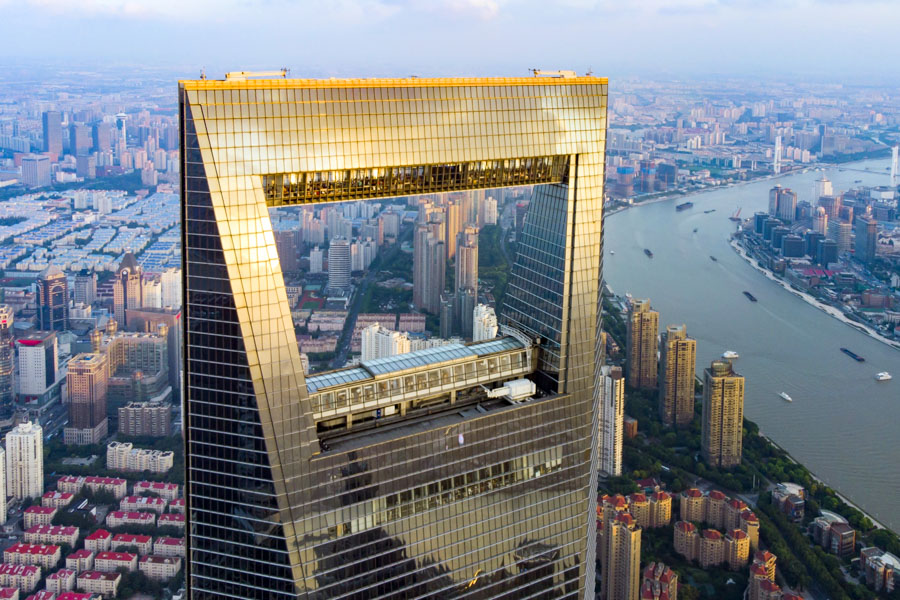
Glass skyscrapers, sweeping silhouettes, and entire neighbourhoods combine with traditional courtyard designs in modern Chinese architecture, creating a vibrant urban landscape.
In cities like Shanghai and Beijing, structures such as the Shanghai Tower and the National Centre for the Performing Arts showcase the use of innovative materials like glass and steel while integrating smart technologies for energy efficiency.
Over the past decade, China has become a hub for urban design, producing cultural complexes, compact modular apartments, and eco-friendly communities. Here, architecture influences daily life, reflecting the ambitious spirit of the nation and the dynamic nature of its megacities. Among China’s most iconic projects that blend cutting-edge technology with creative design, you will find remarkable examples that leave a lasting impression.
In the New Pudong Area (Shanghai)
The Oriental Pearl Tower (东方明珠广播电视塔): Standing at 468 metres (1,535.43 ft), it is the third tallest television tower in Asia.
The Shanghai Tower (上海中心大厦), which was completed in 2015, is China’s tallest building and the third tallest skyscraper in the world. Rising to 632 metres (2,073.49 feet) with 127 floors.
The Shanghai World Financial Center (上海环球金融中心) is one of the city’s most recognisable landmarks. Its distinctive silhouette reaches 492 metres (1,614.17 feet), and features a rectangular cutout at the top, reduces wind pressure while creating a striking visual identity.
In Beijing
The National Stadium “Bird’s Nest” (国家体育场·鸟巢) was built for the 2008 Olympics. It has become one of the most recognisable sports arenas in the world. Its intertwined steel beams resemble a giant nest.
The National Aquatics Center “Water Cube” (国家游泳中心), which is nicknamed the Water Cube. It is known for its translucent façade of bubble-like panels inspired by the structure of water molecules.
In Xi’an
Finally, the Datang Everbright City (大唐不夜城), in Xi’an, is a vast cultural complex that blends modern planning with Tang dynasty themes.
Built Meanings: The Cultural Essence of Chinese Architecture
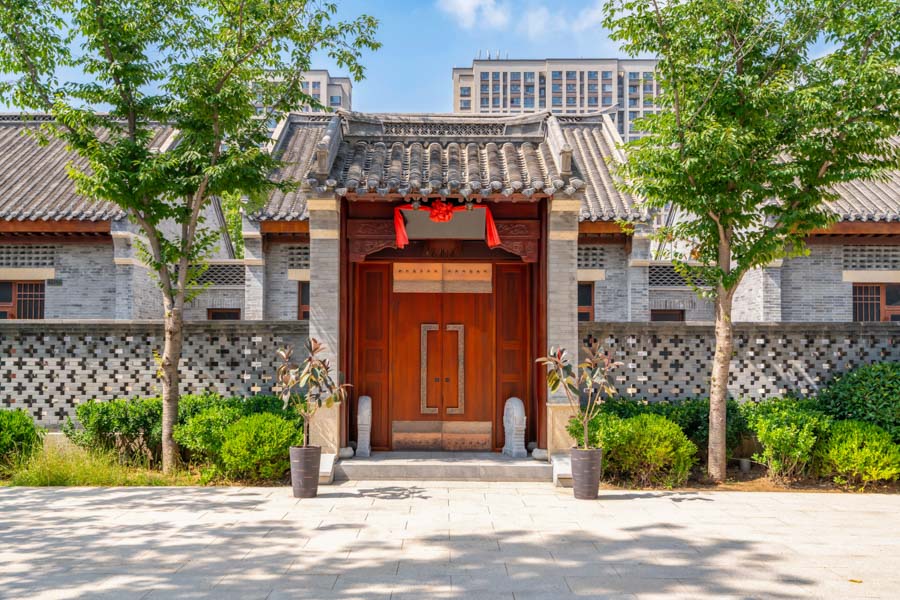
Chinese architecture has always been more than a method of construction – it is an expressive language of culture and philosophy, reflecting the nation’s worldview and core values. Each architectural element carries symbolic meaning: harmony with nature, balance between individual and collective life, and continuity with tradition. Throughout history, from the grandeur of the Forbidden City to the serenity of rural temples, these principles have formed a system where practical function blends with aesthetics and spiritual depth.
The evolution of Chinese architecture traces back through dynasties, showcasing various styles that reflect the cultural shifts of their times. For instance, the intricate details of classical architecture differ from the simpler lines found in modern designs. Regional variations also play a vital role, such as the distinct characteristics of southern wooden temples compared to northern stone structures.
To this day, architecture plays a vital role in celebrations and rituals. Temples host religious festivals and fairs, palace complexes provide settings for state ceremonies, and traditional Siheyuan courtyards serve as venues for family rituals. Iconic structures not only mark the landscape but also embody stories and values that resonate with the people. Pagodas, bridges, and memorial gates often feature in festive processions and commemorative events, underscoring architecture’s enduring place in both social and spiritual life.
The interplay between traditional and modern architecture shows how historical concepts influence contemporary design. Many architects draw inspiration from past principles like balance and unity.
For visitors, appreciating these architectural significances deepens the travel experience and fosters a greater connection to Chinese culture.
Designing the Past: China’s Most Fascinating Architecture Museums
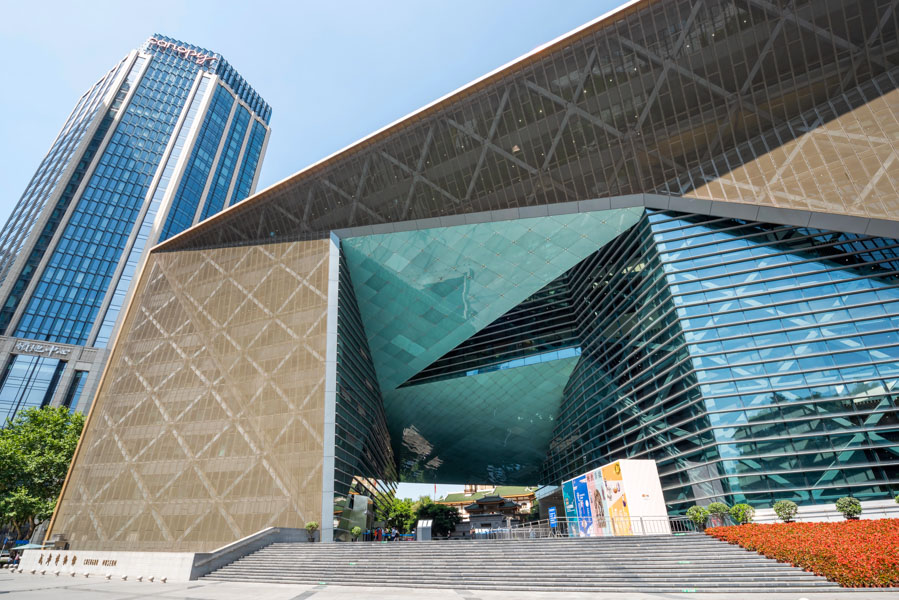
China’s architectural museums offer a unique window into the country’s cultural heritage. Ancient plans, detailed models, and digital exhibits bring lost palaces and neighbourhoods back to life, allowing visitors to follow the centuries-long evolution of Chinese architecture. Notable museums include:
| Museums and their locations | Highlights |
| Beijing Ancient Architecture Museum (北京古代建筑博物馆) No. 21 Dongjing Road, Xicheng District, Beijing, China |
Devoted to ancient architecture |
| Palace Museum (故宫博物院) 4 Jingshan Front St, Dongcheng, Beijing, China |
Dedicated to traditional Chinese architecture’s key principles |
| Architecture Model Museum (建筑模型博物馆) Fengyuzhu Design Building, 191 Jiangchang 3rd Road, Shibei Hi-Tech Park, Jing’an District, Shanghai, China |
Dedicated to contemporary design |
| Shikumen Museum (石库门博物馆) No. 25, 118 Alley, Taicang Road, Luwan District, Shanghai, China |
Highlights Shanghai’s distinctive Shikumen style, blending Chinese and Western element |
| Shanghai Urban Planning Exhibition Hall (上海城市规划展示馆) No. 100 Renmin Main Street, Huangpu District, Shanghai, China |
Focuses on the present and future of Shanghai |
| Banpo Relic Site (半坡遗址) No. 155 Banpo Road, Baqiao District, Xi’an, China |
An open-air museum preserving a 6,000-year-old settlement. |
| Historical Museums with Architectural Highlights and their locations | Highlights |
| Henan Museum (河南博物院) 8 Dongshang Road, Erqi District, Zhengzhou, Henan, China |
Showcases ceramic models of houses and estates from the Western and Eastern Han dynasties. |
| Shaanxi History Museum (陕西历史博物馆) 91 Xian Road, Yanta District, Xi'an, Shaanxi, China |
Houses around 600 frescoes depicting Tang dynasty architecture, important examples of Chinese mural painting. |
| Chengdu Museum (成都博物馆) 231 Dongda Street, Qingyang District, Chengdu, Sichuan, China |
Features building models and urban plans spanning different eras. |
| Du Fu Thatched Cottage, Chengdu (杜甫草堂) 37 Qintai Road, Quigyang District, Chengdu, Sichuan, China |
A memorial complex honouring the 8th-century poet Du Fu. Its reconstructed halls and Tang dynasty ruins evoke the atmosphere of the poet’s time. |
Create Your Journey: Essential Tips for Architecture Lovers in China
- Join expert-led guided tours to explore the history, style, and craftsmanship of architecture in its urban context.
- Explore different eras and styles to discover how ancient temples, wooden palaces, and modern skyscrapers reflect China’s evolving aesthetics.
- Pay attention to details by looking for symbolic carvings, colours, and motifs that reveal hidden meanings behind each structure.
- Experiment with angles and capture façades, courtyards, and skyline views – changing your perspective transforms familiar scenes.
- Attend festivals and celebrations, during holidays, and join themed tours and exhibitions that highlight the cultural significance of architecture.
- Plan transportation by checking routes and transport options in advance for easy access to landmarks.
- Check accessibility and confirm site conditions if mobility is a concern – some areas have stairs or uneven ground.
- Avoid crowds by visiting early or late to enjoy calmer views and better photo opportunities.
- Respect local customs by dressing modestly and following local rules, especially at religious sites.
Chinese architecture is vast and multifaceted, with each discovery unveiling layers of history and culture. To truly appreciate its dynamic evolution, one must travel through China, where the old and the new, traditional and modern, harmoniously coexist – preserved over centuries yet re-imagined with bold creativity.

